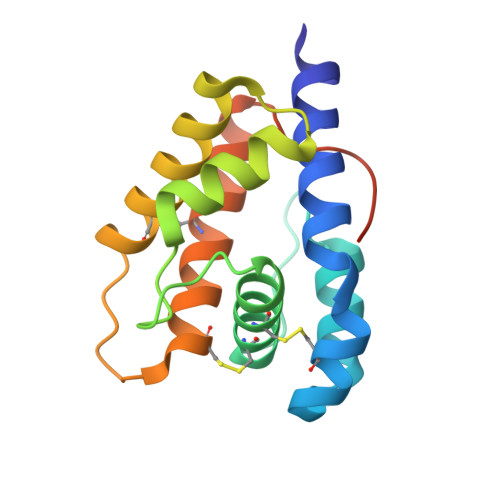Structural Insights into the Ligand-Binding and -Releasing Mechanism of Helicoverpa armigera Pheromone-Binding Protein PBP1.
Zheng, J., Yang, M., Dong, K., Zhang, J., Wang, H., Xie, M., Wu, W., Zhang, Y.J., Chen, Z.(2022) Int J Mol Sci 23
- PubMed: 35163109
- DOI: https://doi.org/10.3390/ijms23031190
- Primary Citation of Related Structures:
7VW8, 7VW9, 7VWA - PubMed Abstract:
Cotton bollworm ( Helicoverpa armigera ) is a worldwide agricultural pest in which the transport of pheromones is indispensable and perceived by pheromone-binding proteins (PBPs). However, three-dimensional structure, pheromone binding, and releasing mechanisms of PBPs are not completely illustrated. Here, we solved three structures of the cotton bollworm HarmPBP1 at different pH values and its complex with ligand, Z -9-hexadecenal. Although apo-HarmPBP1 adopts a common PBP scaffold of six α-helices surrounding a predominantly hydrophobic central pocket, the conformation is greatly distinct from other apo-PBPs. The Z -9-hexadecenal is bound mainly by hydrophobic interaction. The pheromone can enter this cavity through an opening between the helices α5 and α6, as well as the loop between α3 and α4. Structural analysis suggests that ligand entry into the pocket is followed by a shift of Lys94 and Lys138, which may act as a lid at the opening of the pocket. Acidic pH will cause a subtle structural change of the lid, which in turn affects its ligand-binding ability, differently from other family proteins. Taken together, this study provides structural bases for the interactions between pheromones and PBPs, the pH-induced conformational switch, and the design of small inhibitors to control cotton bollworms by disrupting male-female chemosensory communication.
Organizational Affiliation:
State Key Laboratory of Agrobiotechnology, College of Biological Sciences, China Agricultural University, Beijing 100193, China.















